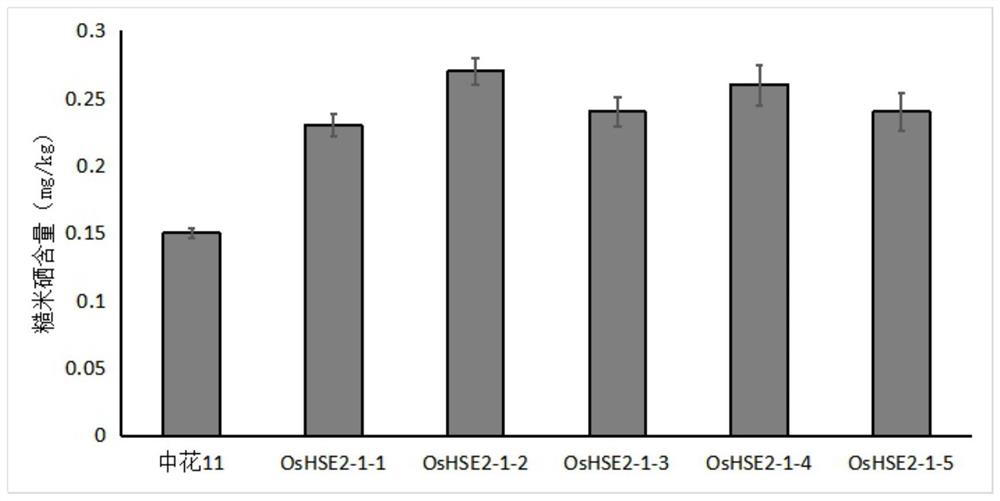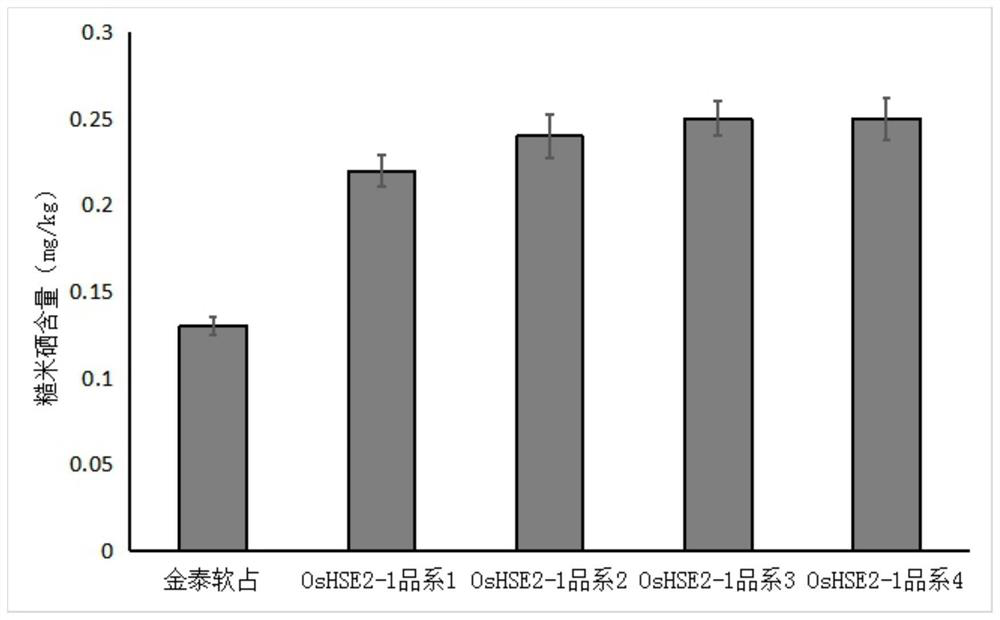Rice selenium-rich gene OsHSE2-1 and application thereof
A technology of transgenic plants and amino acids, applied in the fields of application, genetic engineering, plant gene improvement, etc., can solve the problem of few genes related to selenium accumulation in rice, achieve the effect of enhancing selenium accumulation ability, increasing selenium content, and increasing rice selenium content
- Summary
- Abstract
- Description
- Claims
- Application Information
AI Technical Summary
Problems solved by technology
Method used
Image
Examples
Embodiment 1
[0053] The gene and cDNA clone of embodiment 1 rice OsHSE2-1
[0054] The rice variety Wuyanjing was provided by the National Crop Germplasm Bank, and the materials were planted in greenhouses and managed in the field. Using bioinformatics methods to analyze, design primers, and clone the rice gene OsHSE2-1, the specific methods are as follows:
[0055] Two-week-old young leaves of rice variety Wuyanjing were taken and ground in liquid nitrogen. RNA extraction was carried out according to TIANGEN total RNA extraction kit RNA Plant Extraction kit DP417. The first strand of cDNA was synthesized according to the cDNA first strand synthesis kit TaKaRa PrimeScriptTM 1st strand cDNA Synthesis KitD6110A provided by TaKaRa Reagent Company. For details, please refer to the operating instructions. Using the obtained cDNA fragment as a template, a PCR amplification reaction was performed using the primer pair ATGCAAGCTAAAGAATCCAA (SEQ ID NO: 3) and TCATTCATCACCCCTTGTG (SEQ ID NO: 4). 2...
Embodiment 2
[0057] Example 2 Obtaining of OsHSE2-1 transgenic rice
[0058] 1. Acquisition of pCAMBIA1301-OsHSE2-1 expression vector
[0059] The DNA molecule shown in SEQ ID NO.5 is inserted between BamHI and EcoRI in the pCAMBIA1301 vector, and the pCAMBIA1301-OsHSE2-1 vector (not limited to pCAMBIA1301, as long as it can express the protein whose amino acid sequence is shown in SEQ ID NO: 7), transform Escherichia coli TOP10, and the transformation solution is spread on LB solid medium containing 50 mg / L kanamycin to screen positive clones. After being verified by sequencing, the plasmid was extracted to obtain the plant overexpression vector pCAMBIA1301-OsHSE2-1.
[0060] 2. Obtaining of OsHSE2-1 transgenic rice
[0061] pCAMBIA1301-OsHSE2-1 was transformed into Agrobacterium tumefaciens strain EHA105 by freeze-thaw method. The wild-type rice Zhonghua 11 was respectively transformed by Agrobacterium EHA105. The genomic DNA of transgenic rice was extracted as a template, the wild-t...
Embodiment 3
[0063] Example 3 Functional verification of OsHSE2-1 protein
[0064] Disinfect 5 copies of the T1 generation positive transgenic Zhonghua 11 rice seeds obtained in Example 2 and sow them in tissue culture bottles at a culture temperature of 28°C and a day and night time of 12 / 12 hours; after the rice grows for 3 weeks, transplant it into a potted plant. In the selenium soil, the soil selenium content is 1.0mg / kg, and 4 plants are planted in each pot, and each material (ie OsHSE2-1-1, OsHSE2-1-2, OsHSE2-1-3, OsHSE2-1-4 or OsHSE2- 1-5) Plant 3 pots. The preparation method of the selenium-enriched soil is: each plastic bucket contains 10kg of crushed and sieved air-dried soil (collected at the Nanchang Liantang Experimental Base of Jiangxi Academy of Agricultural Sciences), and 10mg of selenium is added 90 days before transplanting (in the form of 20mg / L sub Sodium selenate (in the form of an aqueous solution of sodium selenate) is mixed evenly, so that the selenium content add...
PUM
 Login to View More
Login to View More Abstract
Description
Claims
Application Information
 Login to View More
Login to View More - R&D
- Intellectual Property
- Life Sciences
- Materials
- Tech Scout
- Unparalleled Data Quality
- Higher Quality Content
- 60% Fewer Hallucinations
Browse by: Latest US Patents, China's latest patents, Technical Efficacy Thesaurus, Application Domain, Technology Topic, Popular Technical Reports.
© 2025 PatSnap. All rights reserved.Legal|Privacy policy|Modern Slavery Act Transparency Statement|Sitemap|About US| Contact US: help@patsnap.com



